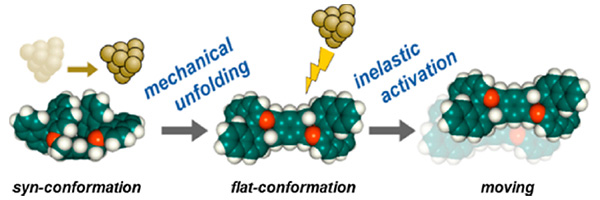- ホーム
- > 研究活動
- > Research Highlights
- > Vol. 32 Driving Soft Molecular Vehicle・・・
 Research Highlights
Research Highlights
[Vol. 32]
Driving Soft Molecular Vehicles on a Metallic Surface
Soft molecules deposited on metallic surfaces were driven using a scanning tunneling microscope (STM) without mechanically pulling or pushing them, but by inducing inelastic excitations with the tunneling current.

Figure: Schematic diagram showing the interaction of tunneling current with molecules.
In nanoscience, compared to rigid molecules, it is challenging to control the movement of soft molecules due to their flexibility. Notably, only one part of soft molecules is suitable for absorbing tunneling current energy that should be used for inducing motion, and not conformational changes of the molecules.
A collaboration led by Waka Nakanishi and Katsuhiko Ariga at WPI-MANA and We-hyo Soe and Christian Joachim at GNS and WPI-MANA Satellite, CEMES-CNRS in Toulouse designed, synthesized and characterized a conformationally flexible molecule consisting of two binaphtyl paddles mounted on a simple phenyl chassis. The vibration modes of the lateral paddles can be exploited to induce the motion of the molecule on an Au(111) surface using STM inelastic tunneling effects. The molecule has two different nonplanar configurations in solution that it retains when absorbed on the surface. However, on the metallic surface it is possible to switch molecules, one at a time, to a flat configuration using a specific STM mechanical manipulation protocol. The flat configuration is the most interesting one for this work, because only flat molecules can be controllably moved on the surface by local STM excitations. Once they assume this configuration, the molecules are reasonably stable on the surface.
Molecules in the flat configuration were characterized to determine the spots where tunneling electrons should be injected to make them move on the surface without mechanically pushing them. Indeed, depending on the location at which the tunneling current enters the molecule, this can assume a nonplanar configuration (different from the original one) instead of moving. If the current is applied on the correct spot, the molecule can move in a controlled way. The experimental characterization of the molecules was complemented by molecular dynamics simulations and density functional theory calculations, which helped to uncover the energetics of the molecules. In April 2017, a ‘nanocar race’ took place, in which several molecular machines synthesized by groups from around the world competed with the goal of covering a set distance on a gold surface in the minimum possible amount of time, driven by STM tips. The molecule presented in this paper is one of the vehicles that took part to the race.
Reference
"Conformation Manipulation and Motion of a Double Paddle Molecule on an Au(111) Surface"
We-Hyo Soe, Yasuhiro Shirai, Corentin Durand, Yusuke Yonamine, Kosuke Minami, Xavier Bouju, Marek Kolmer, Katsuhiko Ariga, Christian Joachim, and Waka Nakanishi
Journal : ACS Nano 11, 10357-10365 (2017).
DOI : 10.1021/acsnano.7b05314
We-Hyo Soe, Yasuhiro Shirai, Corentin Durand, Yusuke Yonamine, Kosuke Minami, Xavier Bouju, Marek Kolmer, Katsuhiko Ariga, Christian Joachim, and Waka Nakanishi
Journal : ACS Nano 11, 10357-10365 (2017).
DOI : 10.1021/acsnano.7b05314
Affiliations
International Center for Materials Nanoarchitectonics (WPI-MANA), National Institute for Materials Science (NIMS), Namiki 1-1, Tsukuba, Ibaraki 305-0044, Japan
Contact information
ナノアーキテクトニクス材料研究センター (MANA)
〒305-0044 茨城県つくば市並木1-1
TEL: 029-860-4710
E-mail: mana-pr=ml.nims.go.jp([ = ] → [ @ ] )
TEL: 029-860-4710
E-mail: mana-pr=ml.nims.go.jp([ = ] → [ @ ] )

